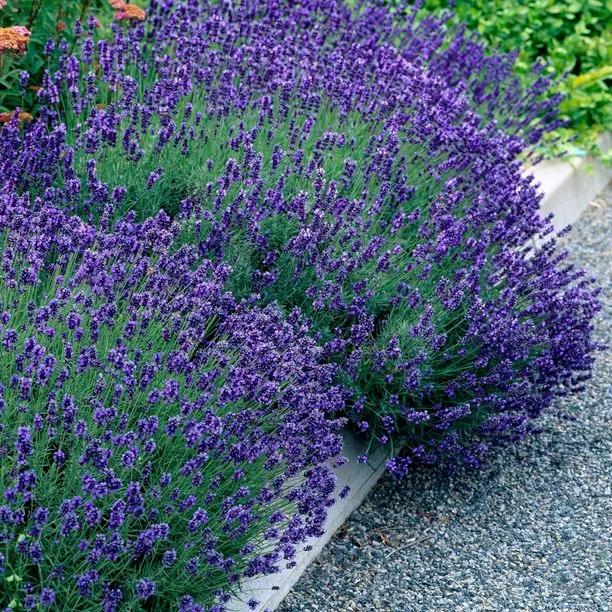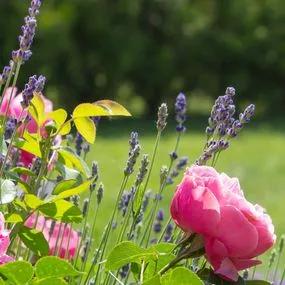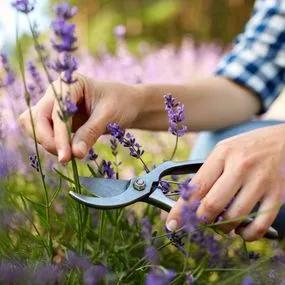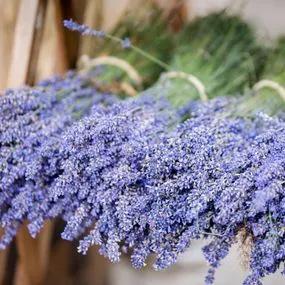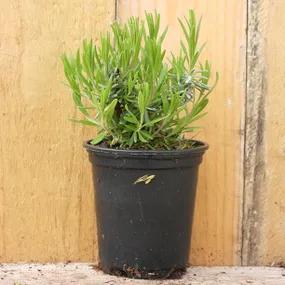Hidcote Blue Lavender Plants
Honest Delivery PricesMost Popular English Lavender!
- Use: Low hedging / edging, basic topiary balls & shapes
- Flowers: Spikes of rich purple-blue
- Flowering: June/July to September
- Scent: Strong, lavender
- Leaves: Evergreen, aromatic. Silvery when mature
- Height x Spread: 60cm x 60cm
- Unappealing to deer, rodents
- Drought tolerant when established
- Culinary herb
- RHS Plants for Pollinators
- RHS Award of Garden Merit
Recommended extras
Description
Lavandula angustifolia 'Hidcote': Classic Purple English Lavender Plants for Sale
Hidcote is the most popular English lavender variety, a great ornamental evergreen hedging plant.
- Order now, pay later: we don't charge your card until before delivery
- When your order is ready: your mail order Lavenders are delivered by next working day courier (not the next working day after ordering!)
- Friendly support: if there is anything wrong with your plants when you inspect them, Contact Us within 5 working days
Delivery Prices
A typical delivery charge for potted shrubs like Lavender is £8 to £15, depending on the order size, if there are no larger plants like trees in the order as well.
Delivery is calculated automatically during checkout after you enter your delivery address.
Delivery Season
Lavender should be planted into warm soil.
If you plant it too early, before nighttime temperatures rise, the roots get shocked and set back, which is especially bad for little plants.
- The smallest lavenders, in P9 pots, are never shipped before May
- The larger pot sizes are usually shipped from the end of April, but cold weather can delay
Delivery Lead Time
- Typically 2 weeks if the plant is actually in stock, rather than available to order before its delivery season
- We process orders in batches to keep costs low
- We keep you notified by email
Choosing a pot size
- For window boxes and other containers, starting with the smallest, cheapest plants in P9 pots is great because it pots them up while putting them to use ornamentally
If you plant them out directly, the best time is late-May into June when the soil is warm and there is plenty of growing time before Winter - For quick borders, hedges and edges, or single shrubs that provide instant impact, larger plants in 2 litre pots are ideal. You get more root and more flower in the first year, and they do not look lost planted as a hedge at one every 13" (33cm)
- For filling a spot in a mature flower border with a lavender muffin-mound, or for a truly instant lavender hedge, we recommend 5 Litre pots as the largest
How many plants per metre?
Spacing a Hidcote Lavender hedge: Like most evergreen hedging, the default spacing is 3 per metre, 33cm apart in a single row.
Features
- Most Popular English Lavender
- Use: Low hedging / edging, basic topiary balls & shapes
- Flowers: Purple-blue spikes
- Flowering: June/July to September
- Scent: Strong, lavender
- Leaves: Evergreen, aromatic. Silvery when mature
- Height x Spread: 60cm x 60cm
- Unappealing to deer, rodents
- Drought tolerant when established
- Culinary herb
- Dry flowers are very fragrant
- RHS Plants for Pollinators
- RHS Award of Garden Merit
Growing Hidcote Lavender
- Aspect: Full sun, South facing
- Soil: Well drained is vital, poorly fertile is preferable
- Soil pH: Above 6.5 is best. Likes chalk
- Hardiness Rating: H5 (to -15C)
- Suitable for the coast and windy locations
- Ideal for large pots & containers
In Your Garden Design
Hidcote is ideal as a low hedging or edging plant for all flower borders and kitchen gardens. The flowers are imperial, deep purple with a good balance between the height of foliage and flower spikes.
It is wonderfully bushy, but ever so slightly shorter and slower growing compared to other English lavender varieties like the paler Munstead. There isn't much in it, but Hidcote suits tight spaces and containers a bit better than more vigorous cultivars.
The pale, silvery, evergreen foliage reflects the light joyously throughout the year; the flowers are a big bonus. Left to itself, it forms a rounded muffin-shaped bush that adds structure to the front of a herbaceous bed, softening the boundary with a lawn or path, and it can be clipped beautifully into simple geometric shapes.
Hidcote's violet goes well with pink roses like Nathalie Nypels. In a potager, Hidcote makes a welcome change from Box when used as elegant, dark flowered edging for a bed full of herbs, which often have purple flowers themselves.
Planting Instructions
Read our guide on how to grow lavender, with a quick pruning video.
Trivia Facts?
Major Lawrence Waterbury Johnston’s mother bought Hidcote Manor in Gloucestershire in 1907; beginning in 1910, Lawrence (1871-1958) went on to create perhaps the most famous Arts and Crafts garden.
Despite being known for Hidcote, his passion was Serre de la Madone, his larger, relatively private garden in Menton, France, which was not continued after his death, contrary to his wishes.
He bred and selected his own plants meticulously, also introducing a Penstemon 'Hidcote Pink' and a Hypericum 'Hidcote Gold'.
Hidcote lavender itself was almost certainly selected in France, but the record has been lost.
Contact Us
- For general enquiries, use our Contact Us form
- If there is any issue with an order you've placed, or for a quote for a large order, our Sales & Support line is 01963 359 444

